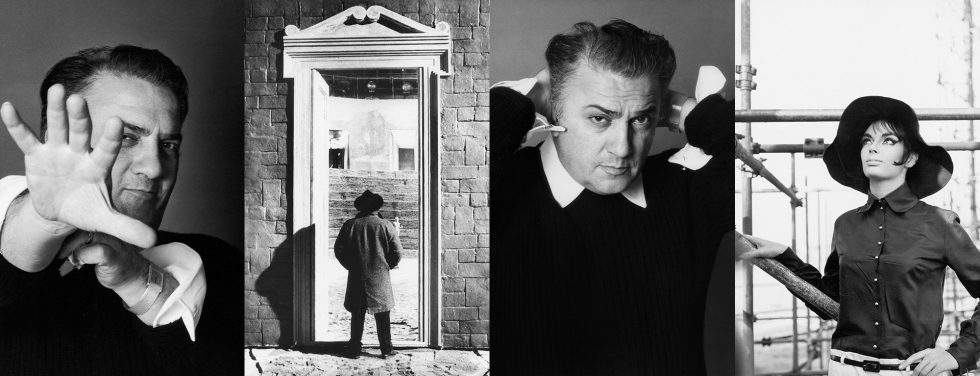In Rome, theIstituto Luce Cinecittà presents, from Feb. 10 to March 21, the exhibition Ri-tratto rosso - Elisabetta Catalano looks at Federico Fellini, a major photographic and multimedia exhibition dedicated to the Rimini director, crowning the tributes for his Centenary, through the gaze of photographer Elisabetta Catalano (Rome, 1944 - 2015).
It was supposed to open in December 2020, at the conclusion of the year that celebrated Federico Fellini’s 100th birthday worldwide. It opens now that health regulations allow it, and in the very Cinecittà that welcomes the public once again, and from which the celebrations for the Master of our cinema symbolically started on January 20, 2020, in his ideal home.
The exhibition, set up in the Cinecittà Studios, inside Theater 1 until March 21, 2021, is curated by Aldo E. Ponis with the artistic direction of Emanuele Cappelli, texts, scientific and iconographic research by Laura Cherubini and Raffaele Simongini, and lives on the images of the extraordinary Elisabetta Catalano Archive.
Ri-tratto rosso tells the story of a dialogue. That between the genius of our cinema and a great international photographer, the queen of photographic portraiture. The one by whom probably more than anyone else Fellini loved to be framed and immortalized. A relationship made up of images created and interwoven over three decades, capable of showing us the work of a great artist, and an unexpected, unseen Fellini.
The exhibition itinerary unfolds through more than 60 images, some of large and very large format, from the Catalano Archive, and shows the five sets of Fellini films that the photographer was called upon to document: 8½ (1963), Fellini Satyricon (1969), Prova d’orchestra (1979), La città delle donne (1980), La voce della luna (19990), with a curious appendix for Intervista (1987).
After Catalano’s visits to Fellini’s sets, the exhibition recounts the exchange of courtesies: Fellini’s visits to the photographer’s studio, for a series of magnificent portraits for which Federico poses episodically and unrepeatably happy and complicit, between 1973 and ’93. An exchange of glances, fulminating visual insights, ending with a brilliant appendix in the portraits devoted to Fellini’s relationship with TV.
Among the images in the exhibition have extraordinary prominence the proofs of the photographs, from which the photographer would then choose that special image that would go to print. Dozens of negatives piled in the same table, on which rarely stands out a circle, a mark, a decisive stroke in red marker: that of the photo to be printed. Catalano was a photographer of hundreds of sitting shots, and very strict was the choice of the ’right shot,’ the result of a meditated, feverish selection. The visitor to Ri-tratto rosso will find shots of incredible beauty and creative clarity, left out by the photographer and her red marker.
The title of the exhibition comes precisely from this marker, and from a recurring color in the imagery of Fellini and the images on display (think only of the director’s famous scarf). The auditions are an authentic work of art among the other photos on display, and an unprecedented glimpse of Fellini’s imagination. Another element the exhibition focuses on is the presence of the original backdrops used by Catalano for the portraits. Large mottled, painterly panels in front of which his models posed, with powerful and poetic color effects. The panels, used here as a document of Catalano’s ’workshop,’ also turn out to be a very strong artistic marker of the setting.
There will also be a reconstruction of a section of the photographer’s studio with the work table, cameras, specimens, and spots, which belonged to and were used by Elisabetta Catalano. A presence that through a special set-up game invites the viewer to ’spy’ inside the studio, as a guest in a special darkroom.
The gallery of studio portraits in the exhibition is the emotional heart of the exhibition. It is here that one finds all the complicity, playfulness, metaphysics and seduction of the Master, synthesized in Elisabetta Catalano’s ’paintings’. The gestures of the hands (the gesture of the ’magician’ Fellini), the sparkling intelligence of the glances stand out. Fellini moves with the late portrait executed close to the awarding of the lifetime achievementOscar, in a tuxedo, dusky but in no way dull. He appears sly, seductive and endlessly complicit as he poses at Cinecittà next to the camera. And lashing out, amused and biting, in the magnificent portraits he concocts with Catalano to ’illustrate’ the controversy with TV, in the years when the director was contesting the intrusiveness of advertising, the decadence of the cinematic illusion in the face of the pervasiveness of televisions, the din of images and chatter of the new society of entertainment that covered the mysterious silence of the darkness of cinema.
Cinecittà is once again opening to the public, sealing with this exhibition the celebrations of Federico Fellini’s centenary, in what is his ideal place of work and spirituality through the images of a great photographer, who precisely in Cinecittà and inside a Fellini set began her luminous career.
The exhibition is promoted and realized by Istituto Luce Cinecittà - Direzione Comunicazione with the support of DG Cinema and Audiovisual in collaboration with Archivio Elisabetta Catalano.
For all information you can visit Cinecittà si mostra.
 |
| A major exhibition at Cinecittà on Federico Fellini with photos by Elisabetta Catalano |
Warning: the translation into English of the original Italian article was created using automatic tools. We undertake to review all articles, but we do not guarantee the total absence of inaccuracies in the translation due to the program. You can find the original by clicking on the ITA button. If you find any mistake,please contact us.